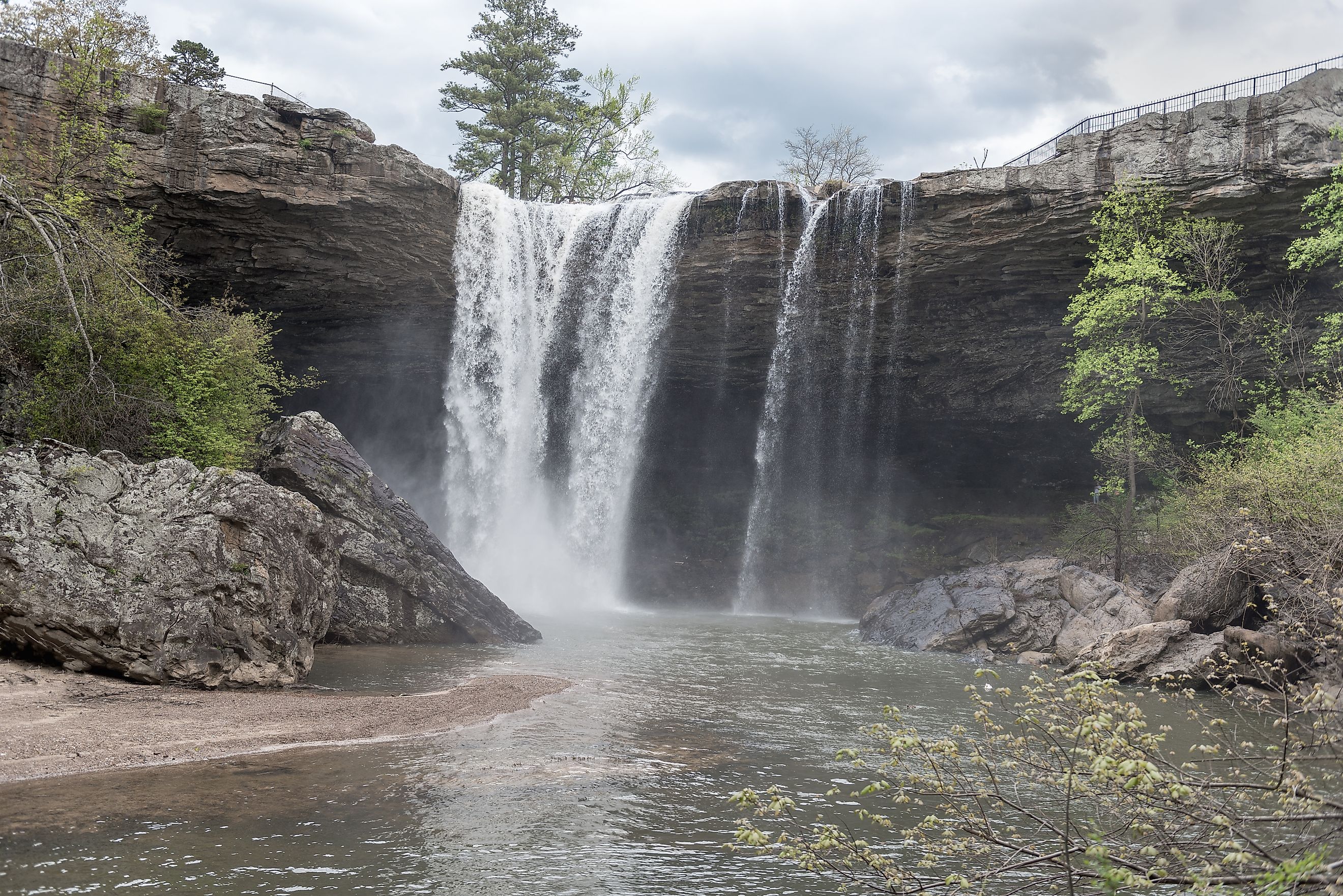
The Natural Wonders in Alabama
Alabama is a state in the iconic Deep South that is chock full of untouched wildlands and a healthy assortment of natural wonders. With a mountainous and forested northern half and a renowned coastline on the Gulf of Mexico, the "Yellowhammer State" is also one of the country's most diverse regions in terms of landscapes that can be found within its borders. From the scenic waters of Mobile to the reaches of Huntsville on the stark other side of the state, let us explore seven of the most wonderful natural destinations in Alabama.
Dismals Canyon
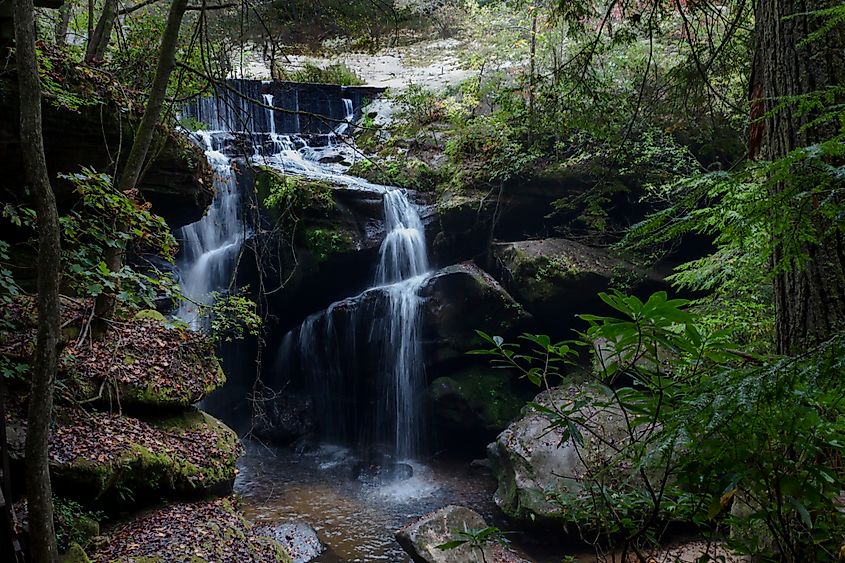
Dismals Canyon is located in the upper-east corner of Alabama and is a hidden gem known for its beautiful geography and trails weaving throughout. Officially designated as a National Natural Landmark, this privately operated nature preserve will give you an up-close look into this ancient, undisturbed wilderness of the South. The canyon is renowned for its sandstone gorges, towering hemlock trees, and lush greenery. For a firsthand experience, visitors can explore the 1.5-mile (2.4 km) hiking trail that winds through the canyon, passing by moss-covered boulders, trickling streams, and picturesque waterfalls like Rainbow Falls and Secret Falls.
One of the canyon's most fascinating features is its population of "Dismalites," bioluminescent insects that emit a blue-green glow, kind of like a living glow stick. These rare creatures are best observed during night tours, where an almost magical, otherworldly atmosphere reminiscent of a starry sky can be seen on the walls of the canyon. Near Dismals Canyon, there are cabins and campsites, allowing you to extend your stay and fully appreciate the natural surroundings of northern Alabama.
Gulf State Park
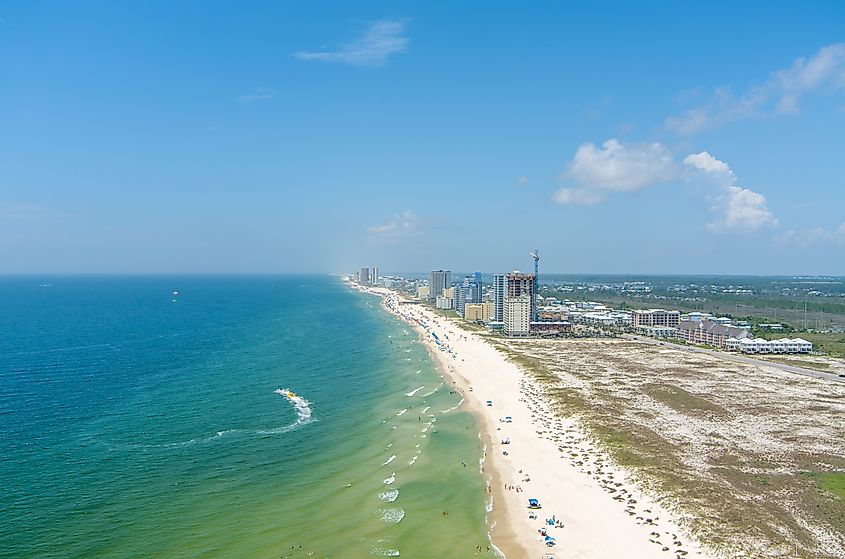
Perched along the Gulf of Mexico near Gulf Shores, Gulf State Park at the far southern edge of the state is hugely popular for its pristine coastal scenery and generally pleasant weather. This park covers 6,500 acres and contains a blend of beaches, freshwater lakes, and woodlands. If you are looking for a relaxing outing, a full two miles of white sandy beaches here are ideal for swimming and sunbathing. Fishing is another fun activity that can be done at various lakes and other waterways in the park. Inland, Gulf State Park holds Shelby Lakes, a 900-acre collection of connected freshwater lakes that are perfect for paddleboarding and boating on top of fishing.
Nearby, the Hugh S. Branyon Backcountry Trail, a network of over 28 miles of paved trails, will take you through the distinct ecosystems in the park, ideal for those interested in wildlife observation. Afterward, one can rest up at the campgrounds, cabins, and Gulf State Park Lodge, which offer a peaceful abode away from the urban hustle and bustle. With so much to see and do, Gulf State Park is an ideal destination to spend a day or two away from the nearby city of Mobile, which sits at the other end of Mobile Bay.
Cathedral Caverns
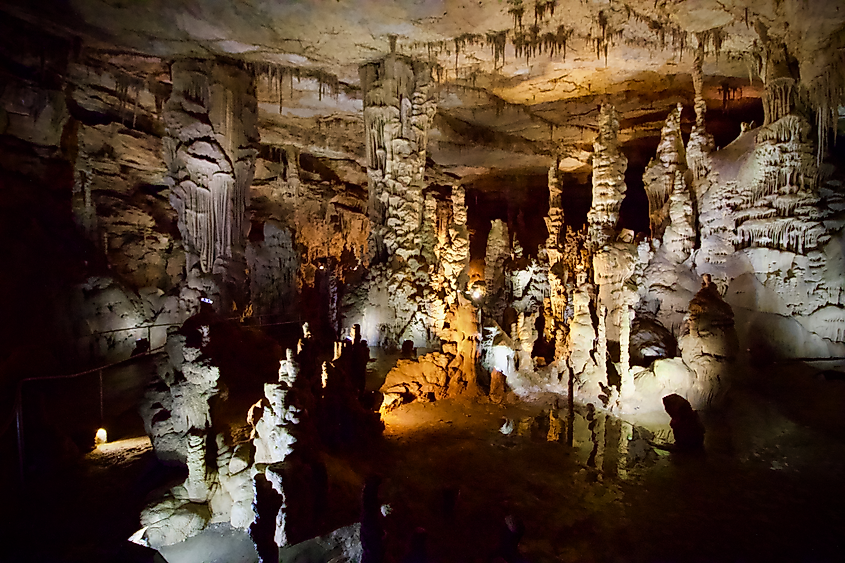
Cathedral Caverns is a remarkable subterranean wonder and the obvious highlight of Cathedral Caverns State Park. This expansive cave system awes visitors with its vast chambers and impressive naturally formed rock formations. The cave's entrance is one of the largest in the world, measuring 25 feet (7.6 m) high and 128 feet (39 m) wide. Inside, adventurers can embark on a guided tour that will take them close to the noted rock formations, including the "Goliath" stalagmite, one of the largest in the world at 45 feet (14 m) tall and 243 feet (74 m) in circumference.
Other notable features include the "Frozen Waterfall," a flowstone formation resembling a cascading waterfall, and the "Stalactite Forest," a dense cluster of stalactites that makes a truly alien-looking landscape. Those willing to brave the depths can also explore "Big Room," a huge chamber measuring 792 feet (241 m) long and 200 feet (61 m) wide that showcases the cave's grandeur. The rest of the state park has additional amenities, including hiking trails, picnicking areas, and campsites. The best part is that Cathedral Caverns is no more than a 40-minute drive from downtown Huntsville, making it easily accessible for tourists.
Natural Bridge
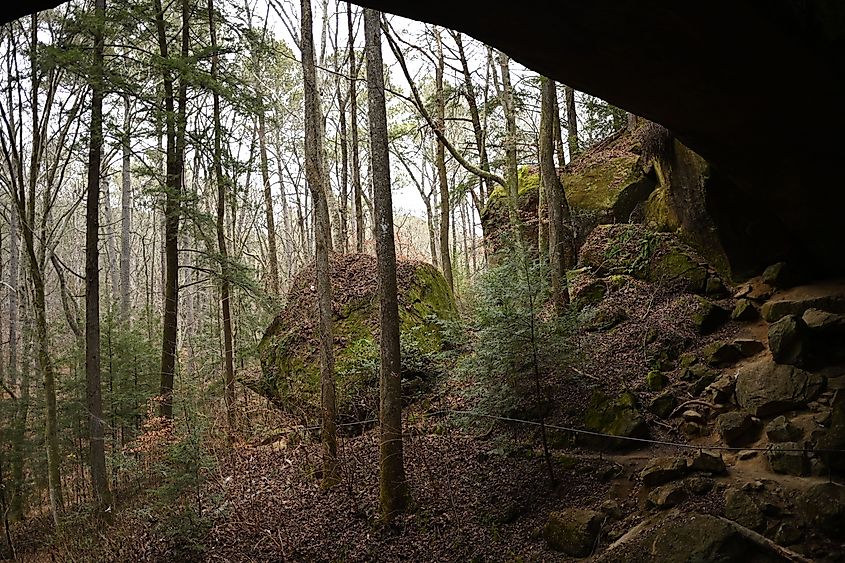
The Natural Bridge is one of Alabama's most intriguing natural attractions. This impressive rock formation, one of a few notable natural bridges around the world, spans 148 feet (45 m) across and stands 60 feet (18 m) high, making it the longest natural bridge east of the Rockies. Moreover, it is believed to be hundreds of millions of years old, with researchers estimating it was formed 200 million years ago.
The bridge is nestled within a 200-acre park of the same name, which is full of opportunities. For hikers, Natural Bridge Park has a short, well-maintained trail leading to the bridge. The trail winds through the surrounding forests and passes by other interesting rock formations and small caves. Points of interest, such as the "Indian Face" rock formation, which resembles a man's face, provide excellent landscape photography opportunities.
Natural Bridge is also rich in history and legend, with local folklore adding an element of mystique to this destination. Some say the "Indian Face" was carved by hand by the native inhabitants of the area, although there is no actual evidence of this yet. Try spotting this rock on your visit and do a bit of investigating for yourself.
William B. Bankhead National Forest
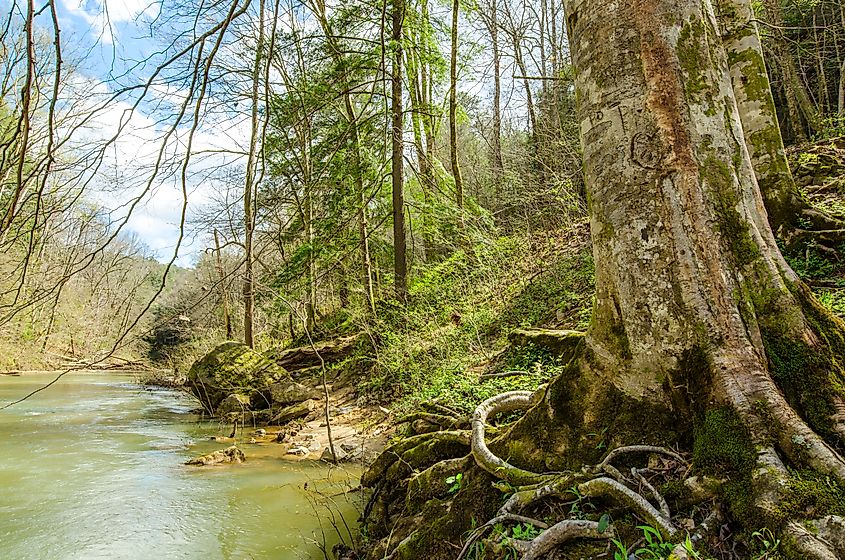
William B. Bankhead National Forest is a large natural area encompassing over 181,000 acres in northwestern Alabama. Named after William B. Bankhead, a prominent U.S. Congressman from Alabama, this forest is protected to help maintain its biodiversity. It provides abundant recreational opportunities and is subsequently one of the most visited parks near Birmingham, a bustling city center nearby.
The forest is home to the Sipsey Wilderness, often referred to as the "Land of a Thousand Waterfalls." This nearly 25,000-acre wilderness area is aptly nicknamed for its numerous waterfalls, several streams, and dense hardwood forests. Some of the best waterfalls to see include Kinlock Falls and Caney Creek Falls. Similarly, the Sipsey River, flowing through the wilderness, is famous for canoeing and fishing.
For those looking to explore, Bankhead National Forest is best seen on its trails, many of which are suitable for hiking, horseback riding, and mountain biking. The popular Borden Creek Trail will give you access to some of the park's most scenic vistas, geological formations, and diverse plant and animal life. Keep your eyes peeled for deer, wild turkeys, and several rare and endangered species, like the Black Warrior Waterdog (a type of aquatic salamander).
Wetumpka Crater
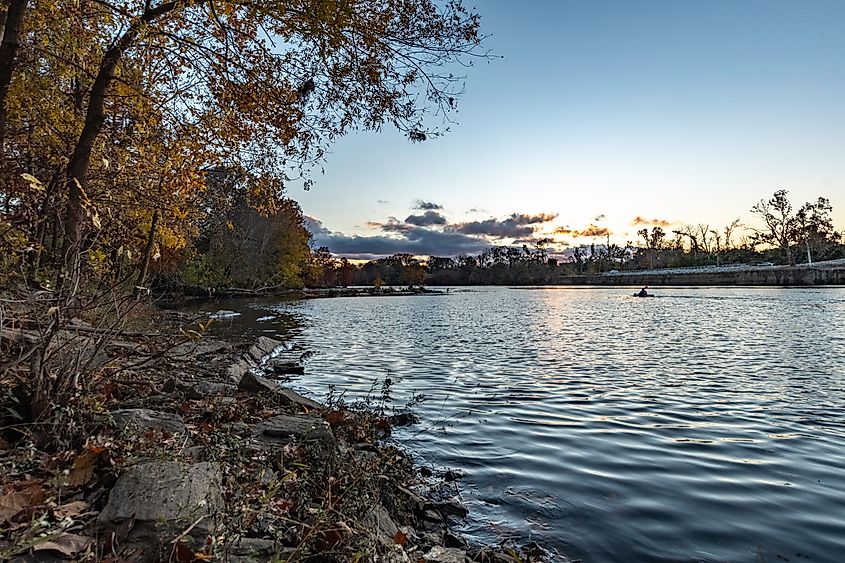
Nearby Alabama's capitol of Montgomery, the Wetumpka Crater intrigues visitors as one of the few confirmed asteroid impact craters in the southeastern United States. Formed approximately 80-85 million years ago during the Late Cretaceous period, the crater spans about 4.7 miles (7.6 km) in diameter and is a window into Earth's ancient history.
The crater was created by the impact of a large asteroid (or possibly a comet), which struck with immense force, creating a deep depression and altering the surrounding land. Over millions of years, the crater has been partially eroded and filled with sediment. However, its distinctive circular structure remains evident, making it an important site for scientific study and education. Visitors to Wetumpka Crater can learn about it through annual guided tours and interpretive signs, like the Wetumpka Impact Crater marker, which explains its formation and significance. The "Wetumpka Crater Tour" is also the name for the popular trails that skirt the impact zone's rim.
Noccalula Falls
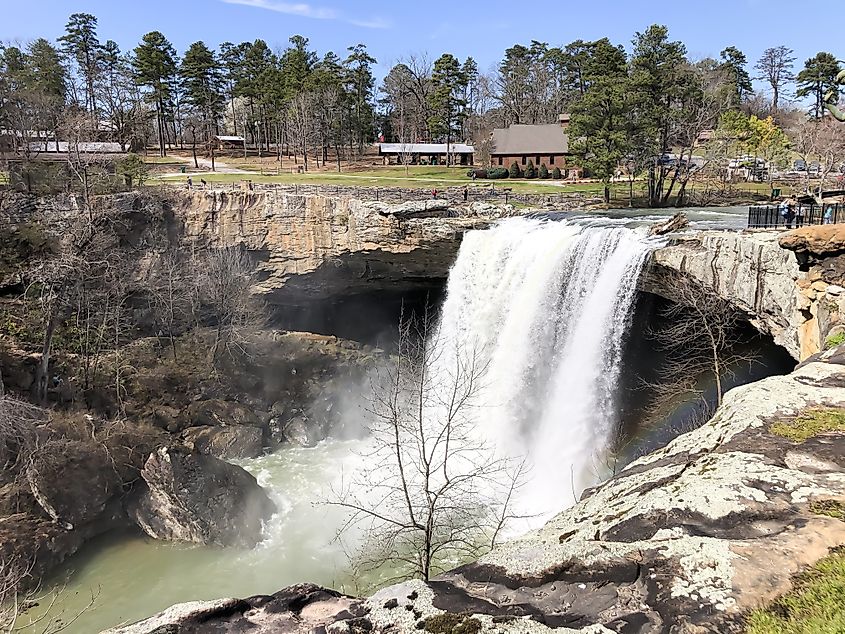
The city of Gadsden features one of Alabama's most stunning waterfalls, Noccalula Falls. This 90-foot (27 m) tall marvel of nature flows over a sandstone ledge into a gorge, offering a scenic view rarely seen elsewhere. The falls are named after the legendary Cherokee princess Noccalula, who, according to local folklore, leaped to her death from the ledge to avoid an arranged marriage. A bronze statue of Noccalula stands near the falls, commemorating this tragic tale.
Surrounding the falls, Noccalula Falls Park encompasses 250 acres, which visitors can explore via trails, both in the canyon and on its rim above the falls. The Black Creek Trail is a popular choice, spanning 1.7 miles (2.7 km) of gravel path with a peaceful environment and lush foliage. There is also a botanical garden and a pioneer village with preserved historic buildings, a perfect way to learn more about the history of this beautiful area. Additionally, the park hosts events throughout the year, including the annual Christmas at the Falls light display.
Alabama's Wilds
Whether out chasing waterfalls or looking for an idyllic park to camp in, you don't have to go far in Alabama to find a picturesque natural setting to escape to. From the shores of Gulf State Park to the geological wonders of Natural Bridge, Alabama offers a diverse and exciting selection of unique destinations that anyone traveling around it should experience. Feel free to come in the summer or winter, as the usually temperate climate here also makes travel easy throughout the year.











